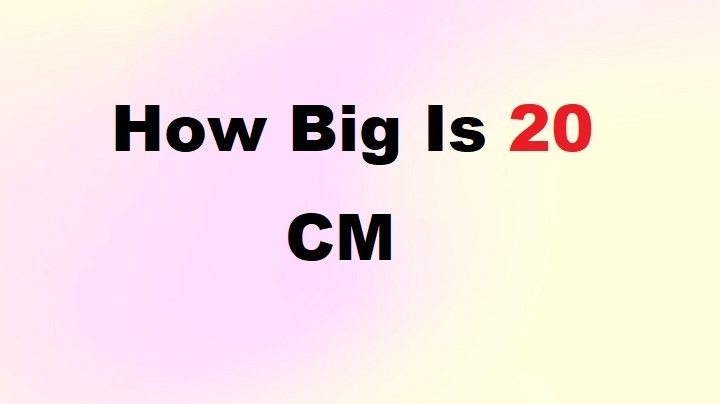How Big Is 20 cm? Simple Visual Guide for Everyday Understanding
Have you ever stopped and wondered, how big is 20 cm? When you see measurements online, in a recipe, or on a product label, it’s easy to get stuck if you can’t picture them. Luckily, 20 centimeters is a common size in many areas of life. This guide will help you clearly understand how big 20 cm is by using easy comparisons, real-world examples, and helpful tips.
What Does 20 cm Look Like?
Basic Conversion: Centimeters to Inches
Before we jump into comparisons, let’s convert:
- 20 cm = 7.87 inches (almost 8 inches).
This is useful if you’re more familiar with inches or need to switch between metric and imperial systems.
Everyday Object Comparisons for 20 cm
To help you picture how big is 20 cm, here are some common comparisons:
- A standard sheet of paper (A4 size) is about 21 cm wide, so 20 cm is just a little narrower.
- A small laptop or tablet screen often measures around 20 cm diagonally.
- A ruler you find in most school supplies is usually 30 cm long, so 20 cm is two-thirds of it.
- A small loaf of bread is roughly 20 cm long.
These easy references help make 20 cm more relatable in daily life.
Where You See 20 cm in Everyday Life
In Home and Kitchen
- A dinner plate typically has a diameter of 20–25 cm.
- A small frying pan or skillet is often 20 cm across.
- Cutting boards can come in compact 20 cm sizes for small prep tasks.
In Fashion and Accessories
- Handbags or purses often measure around 20 cm in width, especially smaller or medium-sized designs.
- Scarf widths or small accessory lengths may also reach 20 cm.
In Tech and Gadgets
- A tablet screen (such as an iPad Mini) usually measures around 20 cm across diagonally.
- Compact speakers or portable devices often have a length or width near 20 cm.
Visualizing 20 cm with Simple Methods
Using Your Hands
Spread your thumb and pinky finger apart — depending on your hand size, the span is often around 20 cm.
Using Household Items
- Two credit cards laid end-to-end equal about 17 cm, so add a little extra for 20 cm.
- A standard water bottle is usually about 20–25 cm tall.
- A pencil or pen can be around 18–20 cm in length.
These tricks help you estimate measurements even if you don’t have a ruler.
Why Knowing 20 cm Is Useful
For Shopping and Online Orders
When you buy items online, knowing how big 20 cm is helps avoid size surprises. Whether you’re ordering a small plant, a picture frame, or a home accessory, you’ll better understand what to expect.
For Cooking and Baking
Recipes or bakeware sizes are often listed in centimeters. Understanding the size ensures you use the right tools or trays.
For DIY and Crafts
Precise measuring is critical in sewing, crafting, or home projects. Being able to visualize 20 cm improves accuracy and results.
Fun Facts About 20 cm
- A guinea pig is about 20–25 cm long, depending on the breed.
- A large smartphone is roughly 15–17 cm tall, so 20 cm is slightly taller.
- A standard paperback book is about 20 cm tall, making it a perfect reference point.
These fun comparisons stick in your mind and make measuring easier next time.
FAQs About How Big Is 20 cm
How many inches is 20 cm?
Twenty centimeters equals 7.87 inches, or almost 8 inches.
What common items are about 20 cm long?
A dinner plate, a paperback book, or a standard frying pan all measure around 20 cm.
How can I measure 20 cm without a ruler?
Use two credit cards laid end-to-end (about 17 cm) and add a little, or compare to the length of a pencil or standard water bottle.
Is 20 cm a small or large measurement?
It’s a medium size — small compared to large objects like furniture but big when measuring small accessories or gadgets.
Why is knowing 20 cm important?
It helps with shopping, cooking, crafting, and understanding product sizes without needing constant measuring tools.
So, how big is 20 cm? It’s a versatile, medium-sized measurement you encounter daily — from plates and pans to books and devices. By using everyday comparisons and simple visual tricks, you can confidently estimate and understand 20 cm in any situation. This knowledge saves you from mistakes, helps you plan better, and sharpens your measurement awareness.








